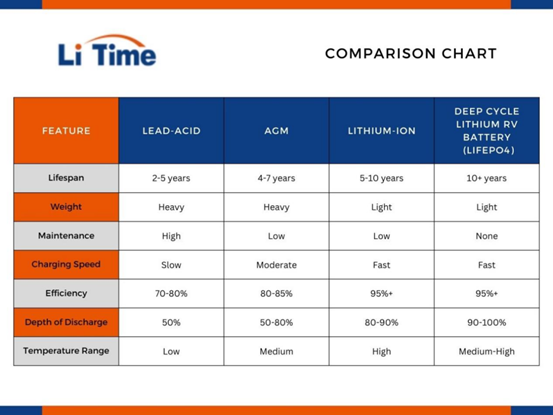Which Battery is Best for RV Travelers?

Starting your RV adventure with a reliable power source is crucial for a comfortable and hassle-free journey. Choosing the right battery type is vital for any RV traveler. But which battery best suits your RV needs? What exactly is a deep cycle lithium RV batteries, and what kind of power do appliances like your fridge and air conditioner need? This guide will answer all your questions and help you make an informed decision. Here’s what you’ll find:
What Are RV Batteries?
RV batteries are specifically engineered to supply power to your RV’s electrical systems and generally fall into two categories:
Starting Batteries:
o Function: Primarily used for starting the RV’s engine, delivering a quick burst of high current.
o Key Traits: Built for high-output, short-duration energy bursts, and not intended for continuous power supply.
Deep Cycle Batteries:
o Function: These are the workhorses that provide steady, ongoing power to your RV’s onboard devices, including lights, refrigerators, air conditioning, and other electronics.
o Key Traits: Designed for deep, sustained discharge, making them the backbone of your RV’s power system and essential for extended off-grid stays.
Why Should You Pay Attention to RV Batteries?
- Keep Your RV Devices Running Smoothly:
From lights and refrigerators to air conditioners and electronics, your RV’s essential devices all depend on battery power. A reliable battery system ensures these appliances function correctly, whether you’re on the move or parked, significantly enhancing your RV living experience and overall travel comfort.
- Enhance Your Travel Independence and Freedom:
Travel habits in the U.S. are shifting dramatically. The RV industry contributes about $140 billion to the U.S. economy each year, highlighting the unparalleled sense of freedom and unique experiences that RV travel offers. A strong battery system empowers RV travelers with greater independence, freeing them from the need to rely on campsites or external power sources, thus enabling truly go-anywhere, anytime journeys.
- Accommodate Diverse Power Needs:
RVs are used in a variety of scenarios, from simple daily power consumption to running complex electronics and household appliances. A robust and versatile battery system is capable of meeting all these demands, ensuring you have a reliable power supply no matter where your adventures take you.
In-Depth Guide to RV Battery Types:
Choosing the right battery for your RV is key to enhancing your travel experience. Here, we compare four popular RV battery types: Lead-Acid, AGM (Absorbent Glass Mat), Lithium-Ion, and Deep Cycle Lithium RV Battery (LiFePO4) to help you make the best choice.
Lead-Acid Battery
The most traditional and widely used RV batteries, lead-acid options include flooded, gel, and AGM types.
Pros:
- Cost-Effective: Lead-acid batteries are one of the most budget-friendly options, great for RVers looking to save.
- Easily Accessible: Well-established technology means easy access to replacements and repairs.
Cons:
- Short Lifespan: They wear out faster and need more frequent replacements, driving up long-term costs.
- Heavy: Their substantial weight can affect your RV’s fuel efficiency.
- Requires Maintenance: Needs regular checks for electrolyte levels and proper ventilation, adding to upkeep.
AGM Battery
A step up from traditional lead-acid, AGM batteries use glass mats to absorb electrolytes, making them more secure and sealed.
Pros:
- Low Maintenance: No need to add water, making them more user-friendly.
- Higher Efficiency: Offers better charging and discharging performance compared to standard lead-acid batteries.
- Enhanced Safety: Less prone to leaks and more stable under rough conditions.
Cons:
- Still Heavy: Although somewhat lighter than standard lead-acid, they’re still on the heavier side.
- Moderate Lifespan: Longer than regular lead-acid but falls short of lithium alternatives.
- Sensitive to Over-Discharge: Deep discharging can reduce lifespan, requiring careful monitoring.
Deep Cycle Lithium RV Battery (LiFePO4)
LiFePO4 deep cycle batteries are increasingly becoming the go-to choice for RVs due to their outstanding performance and reliability.
Pros:
- Extended Lifespan: Can endure thousands of charge cycles, vastly outlasting other types.
- Lighter Weight: Significantly reduces overall RV load, improving efficiency.
- Rapid Charging: Charges quickly, perfect for when you need power in a pinch.
- High Efficiency: Excellent charge and discharge rates, maximizing energy use.
- Maintenance-Free: No regular upkeep needed, making them hassle-free.
- Broad Temperature Range: Operates reliably across a wide temperature spectrum.
Cons:
- High Initial Investment: Costs more upfront but offers great long-term value.
- Special Charging Equipment Needed: Requires dedicated chargers, adding to initial expenses.
Comparing RV Battery Types: FLA, AGM, Lithium-Ion, and Deep Cycle Lithium RV Battery (LiFePO4)
Choosing the right RV battery depends on several factors, including performance requirements and budget. Here’s a quick comparison of the four main types: Lead-Acid, AGM, Lithium-Ion, and Deep Cycle Lithium RV Battery (LiFePO4).
To get a clearer picture, let’s dive deeper into AGM and Deep Cycle Lithium (LiFePO4) batteries, focusing on three key factors:
- Depth of Discharge (DoD):
DoD refers to how much capacity is used up in a battery, which directly impacts performance and longevity. Simply put, if a battery drains from full (100%) to half (50%), that’s a 50% DoD. Deep Cycle Lithium RV batteries (LiFePO4) handle deep discharges (80%-100%) without major impacts on lifespan, making them resilient even with frequent deep cycling. On the other hand, AGM batteries are best kept at 50% DoD or less, as deeper discharges can significantly shorten their lifespan.
Example:
A 400Ah AGM battery typically offers only 200Ah usable capacity, whereas a LiTime 12V 400Ah LiFePO4 battery can provide nearly the full 360Ah-400Ah.
- Weight Considerations:
Since RVs have specific weight limits (GVWR), keeping your vehicle’s weight in check is essential for safety, affecting braking, handling, and tire wear. AGM batteries are generally two to three times heavier than LiFePO4 batteries of similar capacity.
Example:
A 12V 100Ah AGM battery weighs at least 60 pounds, while a comparable LiTime 12V 100Ah LiFePO4 battery weighs around 24.25 pounds.
- Cost Analysis:
Cost should factor in both initial outlay and long-term expenses, including potential subsidies.
(1) Long-Term Costs
AGM batteries typically last 300-500 cycles, needing replacement every 1-2 years with regular use. LiFePO4 batteries offer over 4,000 cycles, potentially lasting over 10 years with daily use.
Example:
If a lead-acid battery costs $100 and lasts 500 cycles, and a LiFePO4 battery costs $300 with a 4,000-cycle life, the lead-acid battery would need 8 replacements (4,000/500 cycles), costing $800 total. The LiFePO4 battery would only require the initial $300 investment.
(2) Available Incentives
The U.S. government is increasingly supporting sustainable energy solutions, including advanced battery technologies like LiFePO4, known for safety, efficiency, and environmental benefits.
The 2022 Inflation Reduction Act (IRA) provides significant tax incentives and rebates for clean energy technologies, including LiFePO4 batteries. Under the IRA, consumers installing energy storage systems, such as deep cycle lithium batteries for RVs, can receive tax credits, aimed at reducing greenhouse gas emissions and accelerating the shift to renewable energy.
Determining the Right Battery Capacity for Your RV
Once you know the different types of RV batteries, finding the right battery capacity is key to optimizing your RV’s electrical setup. Here’s a guide on how to choose battery capacity based on the size of your RV and its power needs:
Small Campers (Class B / Camper Vans):
- Size: Typically 16-20 feet (5-6 meters) long.
- Power Needs: Best for short trips or solo/couple use with modest power requirements. A battery capacity of 100-200Ah is sufficient for basic lighting, charging small devices like phones and laptops, and running a few small appliances like a mini-fridge or fan.
Medium RVs (Class C / Small Motorhomes):
- Size: About 20-26 feet (6-8 meters) in length.
- Power Needs: Suitable for families with higher energy needs, including air conditioning and kitchen appliances. A capacity of 200-400Ah is recommended, with adjustments depending on how many devices you run and how frequently you use them.
Large RVs (Class A / Large Motorhomes):
- Size: Typically over 26 feet (8 meters), some even exceeding 40 feet (12 meters).
- Power Needs: These RVs are equipped with multiple appliances such as several air conditioners, large refrigerators, microwaves, and entertainment systems. A battery capacity of 400Ah or more is recommended, and for longer off-grid stays, you might need up to 1000Ah or more.
Travel Trailers / Fifth Wheels:
- Size: Range varies from small trailers (4-5 meters) to large models (over 10 meters).
- Power Needs: Depending on size and equipment, battery capacity can range from 100Ah to over 1000Ah, tailored to your specific energy needs.
When selecting battery capacity, consider other factors such as whether you have solar panels, the frequency of your RV use, and the types of loads (like the power needs of your inverter). Battery type matters too; deep cycle lithium RV batteries, especially LiFePO4, are increasingly preferred for their light weight, longevity, and stable performance, making them the leading choice in RV power systems.
Conclusion
Choosing the right battery is a crucial part of RV travel. Deep cycle lithium RV batteries, particularly LiFePO4, are emerging as the top choice for RV power due to their extended lifespan, light weight, superior depth of discharge, and excellent charging efficiency. Compared to traditional lead-acid and AGM batteries, LiFePO4 batteries not only offer long-term cost savings but also enhance your RV’s range and travel freedom. Deep cycle lithium batteries provide reliable power, ensuring your devices run smoothly even off the grid. Their maintenance-free operation and broad temperature adaptability make them an ideal choice for RV enthusiasts.
Read More From Techbullion





